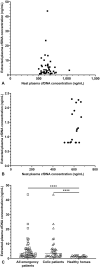Investigation of plasma cell-free DNA as a potential biomarker in horses
- PMID: 35168428
- PMCID: PMC9254060
- DOI: 10.1177/10406387221078047
Investigation of plasma cell-free DNA as a potential biomarker in horses
Abstract
Plasma cell-free DNA (cfDNA) is a biomarker of ischemia, systemic inflammation, and mortality in humans with gastrointestinal disease. Cell-free DNA has not been investigated as a biomarker for equine colic, to our knowledge. We hypothesized that cfDNA could be measured accurately in neat equine plasma using a benchtop fluorometer and that plasma cfDNA would be elevated in emergency patients compared to healthy horses. Plasma was obtained from blood collected in Roche DNA stabilizing tubes. We used the Qubit 4 fluorometer and 1× dsDNA HS assay kit to measure cfDNA concentration in neat patient plasma and following DNA extraction of plasma with a commercial kit. Assay precision and linearity of dilution were satisfactory for neat plasma cfDNA, but DNA spike and recovery results were variable. Further, cfDNA concentrations in paired neat plasma and extracted-plasma samples (n = 66) were not correlated. Median extracted-plasma cfDNA was higher in emergency patients (n = 50) and a subgroup of colic patients (n = 36), compared to healthy horses (n = 19). Our results with extracted-plasma samples provide proof of concept for further investigation of plasma cfDNA as a biomarker in horses.
Keywords: biomarker; cell-free DNA; cfDNA; colic; equine; gastrointestinal.
Conflict of interest statement
Figures

References
-
- Arnalich F, et al.. Association of cell-free plasma DNA with perioperative mortality in patients with suspected acute mesenteric ischemia. Clin Chim Acta 2010;411:1269–1274. - PubMed
-
- Barrett AN, et al.. Stability of cell-free DNA from maternal plasma isolated following a single centrifugation step. Prenat Diagn 2014;34:1283–1288. - PubMed
-
- Burnett DL, et al.. Investigation of cell-free DNA in canine plasma and its relation to disease. Vet Q 2016;36:122–129. - PubMed
MeSH terms
Substances
Grants and funding
LinkOut - more resources
Full Text Sources

